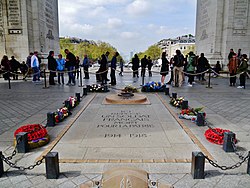Arc de Triomphe

The Arc de Triomphe de l'Étoile is commonly known as Arc de Triomphe (meaning arch of victory). It is a famous monument in Paris. It is at the centre of the Place Charles de Gaulle. This was formerly called the Place de l'Étoile at the western end of the Champs-Elysées.
Emperor Napoléon Bonaparte commissioned it in 1806 after victory in the Battle of Austerlitz. It was inaugurated on 29 July 1836. It is a large arch, but it is not possible to drive underneath it. Jean-François Chalgrin designed it, and it has roughly 300 steps that lead to the top. It has four main sculptures and six reliefs. Just beneath the vault of the arch, there is the tomb of the unknown soldier. The names of French generals and battles are engraved on the walls. The first stone was laid on August 6th, 1806. It is over 160 feet high and serves as a gate/entryway for the city.
+{{{1}}}−{{{2}}}
Arc De Triomphe Media
Avenues radiate from the Arc de Triomphe in Place Charles de Gaulle, the former Place de l'Étoile.
The Arc de Triomphe is located on Paris's Axe historique, a long perspective that runs from the Louvre to the Grande Arche de la Défense.
Battle of Austerlitz, 2 December 1805, painting by François Gérard displayed in the Gallery of the Battles, at the Palace of Versailles.
Free French forces on parade after the liberation of Paris on 26 August 1944.
Jean Chalgrin's drawing of the Arc de Triomphe, 1806.
Tomb of the Unknown Soldier beneath the Arc de Triomphe.
State funeral of Emperor Napoleon, 15 December 1840.








